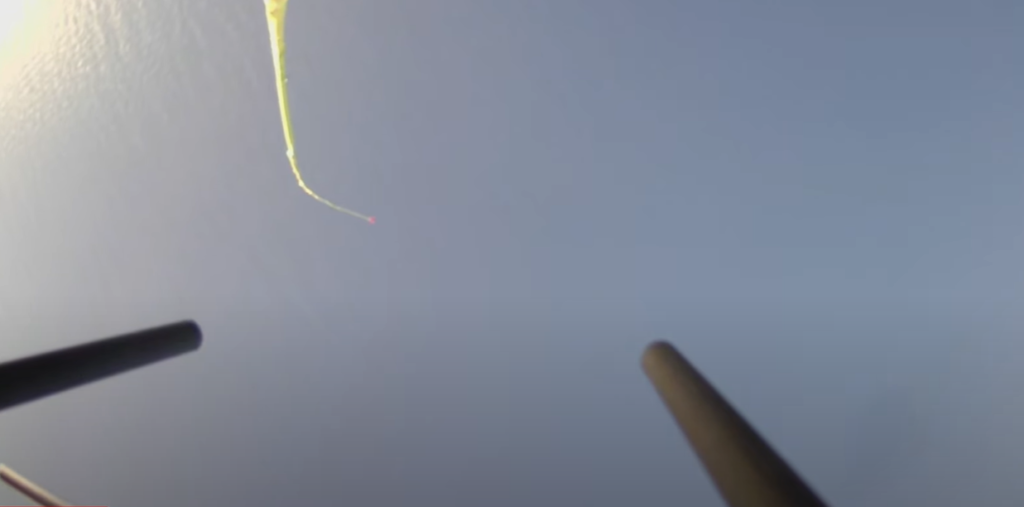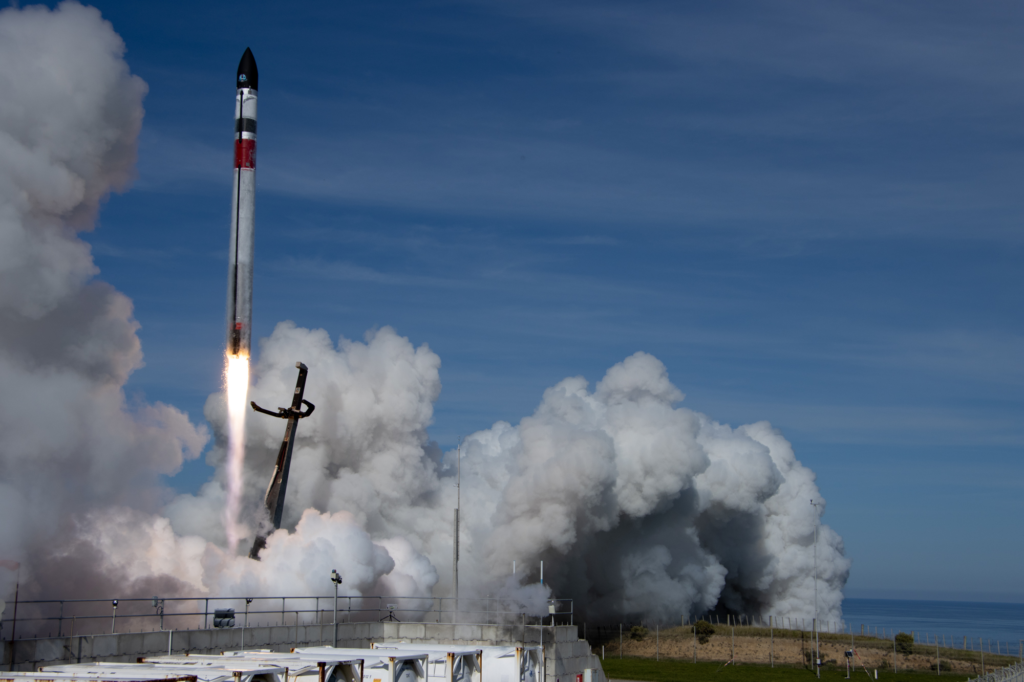
Rocket Lab Was Unable To Catch Electron’s Booster In Today’s Launch
Throughout the space industry more and more companies are working toward either partial or full reusability. Depending on the launch vehicle, this can offer quite a few benefits if done successfully including cost savings and a significant increase in launch cadence. Rocket Lab is a great example that is not only working on an almost fully reusable Neutron rocket, but also the partial reusability of Electron.
Today we watched the company’s second ever booster catch attempt during an actual mission. Earlier this year during the There And Back Again mission the company was able to catch the booster but had to drop it in the water due to a few complications. Unfortunately, on this second attempt, Rocket Lab was unable to catch and return the stage back via helicopter.
Rocket Lab has often pointed out that catching a rocket booster out of mid air is an immensely difficult task. With today’s miss, it brings up the question of what is Rocket Lab’s plan going forward for Electron reusability, and what led to the booster landing in water. Here I will go more in-depth into what exactly happened on today’s catch attempt, where is the booster now, what to expect in the future, and more.
Today’s Catch Attempt

Launched from Pad B at Rocket Lab Launch Complex 1 on New Zealand’s Mahia Peninsula, the “Catch Me If You Can” mission was Rocket Lab’s 32nd Electron launch overall and second reusability mission of 2022. This mission saw Rocket Lab attempt to capture the rocket’s first stage mid-air with a helicopter as it returned from space. Using a modified Sikorsky S-92 helicopter to catch and secure the rocket by its parachute line, Rocket Lab was hoping to bring captured stage back to its Auckland Production Complex to be processed and assessed by engineers and technicians for possible re-use. Unfortunately, while the mission and payload deployment were a success, Rocket Lab was unable to come in contact with the falling booster and catch it.
The mission began at 1:27 EST when Electron lifted off from Pad B. Just over a minute in the rocket reached Max q with no problems. About 1 minute and a half later we watched a successful stage separation as the upper stage continued on into orbit while the first stage began its journey back toward earth. However, a bit past 17 minutes into the launch, mission control announced that they were updated by the pilots and would not be able to bring Electron back dry. They also pointed out that there was a backup option of an ocean splashdown. Specifically, Rocket Lab tweeted clarifying, “We’ve just had an update from the recovery team and unfortunately it looks like we are not going to bring Electron home dry today, but we do have the back up option of an ocean splashdown so we’ll bring you updates on that operation in the hours to come.
In addition, CEO of Rocket Lab Peter Beck said a few hours after the attempt, “Rocket telemetry dropped out (it happens a bit during reentry) but we did not regain a solid link in time. Without that link it’s just not safe to put the helicopter into the recovery zone, so we stood it off. The great thing about recovery is you get it back to see what happened” Based on this and a few other statements regarding this launch, it looks as if Rocket Lab is planning to try to catch the booster again sometime in the future. On the bright side, the payload was successfully placed in its intended orbit. After the mission, Rocket Lab tweeted again mentioning, “Congratulations @RymdstyrelsenSE and OHB Sweden on MATS’ deployment to space! Catch Me If You Can was our ninth mission this year, bringing total satellites deployed by Electron to 152.” Peter Beck also commented after the launch saying, “Bringing a rocket back from space is a challenging task and capturing it mid-air with a helicopter is as complex as it sounds. “The chances for success are much smaller than that of failure because many complex factors that must perfectly align. We are proud to have successfully recovered our fifth rocket from the ocean now and we look forward to another mid-air capture attempt in future as we work toward making Electron a reusable rocket.”
Why Catch Electron’s Booster?

Now that we know more about today’s catch attempt and how exactly it went, we can take a closer look at why Rocket Lab is even trying to make Electron partially reusable and whether or not this process is worth it for a small lift launch vehicle. Rocket Lab highlights that they are trying to make Electron partially reusable in an effort to increase launch opportunities and reduce manufacturing costs.
For multiple years now Rocket Lab has been working toward this milestone with different reusability missions. For example, back in 2019, the ‘Running Out Of Fingers’ mission featured the first guided, full telemetry re-entry of the Electron first stage as part of the recovery program. Recovery instrumentation on-board this flight included guidance and navigation hardware, including S-band telemetry and on-board flight computer systems, to live-gather data during the first stage’s atmospheric re-entry, as well as a reaction control system to orient the booster. During multiple missions in 2020 and 2021, Electron’s first stage was successfully brought back to Earth under a parachute. The stages completed controlled water landings before collection by a recovery vessel. These missions marked major milestones in the recovery program and informed design and operational processes for an eventual helicopter capture attempt.
Then there was the first actual attempt earlier this year. In this case, Electron’s first stage returned to Earth under a parachute. At 6,500 ft, Rocket Lab’s Sikorsky S-92 helicopter rendezvoused with the returning stage and used a hook on a long line to capture the parachute line. Rocket Lab said that the mid-air capture was a major milestone in Rocket Lab’s pursuit to make Electron a reusable rocket to increase launch frequency and reduce launch costs for small satellites. However, after the catch, the helicopter pilot detected different load characteristics than previously experienced in testing and offloaded the stage for a successful splashdown. At the time, Peter Beck commented, “Bringing a rocket back from space and catching it with a helicopter is something of a supersonic ballet. A tremendous number of factors have to align and many systems have to work together flawlessly, so I am incredibly proud of the stellar efforts of our Recovery Team and all of our engineers who made this mission and our first catch a success. From here we’ll assess the stage and determine what changes we might want to make to the system and procedures for the next helicopter catch and eventual re-flight.”
The reason these past attempts are important has to do with the feasibility of catching Electron’s booster. While Rocket Lab is no doubt improving, catching a falling rocket booster with a helicopter is an immensely difficult process. To put it in perspective, Peter Beck himself has said, “Trying to catch a rocket as it falls back to Earth is no easy feat, we’re absolutely threading the needle here, but pushing the limits with such complex operations is in our DNA.” If the company is not able to consistently catch the booster, then this process may not be worth the added costs and complexities. However, if Rocket Lab begins catching almost every booster with ease, it’s possible the refurbishment process is much quicker and both costs and launch cadence can be significantly improved.
One of the most significant results from the catch attempt earlier this year was work on refurbishing the Rutherford engine. Just over two months ago the company announced they successfully test fired a reused Rutherford first stage engine for the first time – a significant technical achievement in the Company’s efforts to make its Electron launch vehicle the world’s first reusable orbital small rocket. The refurbished Rutherford engine passed all of the same rigorous acceptance tests Rocket Lab performs for every engine, including 200 seconds of engine fire and multiple restarts. Data from the test fire showed the engine produced full thrust of 21 kilonewtons within 1000 milliseconds of ignition and performed to the same standard of a newly-built Rutherford engine.
Rocket Lab founder and CEO Peter Beck said: “We’ve always been at the forefront of innovation with Electron, having pushed the boundaries of many technologies including carbon composites, electric turbo-pumps and 3D printed rocket engines. Now, we’re leading the pack once again bringing reusability to small launch vehicles. “Being able to refly Electron with minimal refurbishment is the ultimate goal, and so the fact that the recovered components on this engine performed on the test stand with minimal rework is further validation that we’re on the right path. If we can achieve this high level of performance from engine components recovered from the ocean, then I’m optimistic and incredibly excited about what we can do when we bring back dry engines under a helicopter next time.”
Rocket Lab has been a very fun company to watch over the last few years. Their continued ambition a work on unique projects and goals is a big reason for both the company’s success and overall results. Even though the result today was not exactly what Rocket Lab wanted, the next attempt is likely to be just around the corner. All of which comes in addition to even more work on Neutron, Launch Complex 2, general facilities, and more.
Conclusion
Rocket Lab has been working to make Electron a partially reusable rocket for multiple years now. While the catch attempt was not successful today, they will no doubt gain invaluable information and try again in the future. We will have to wait and see how it progresses and the impact it has on the space industry.
